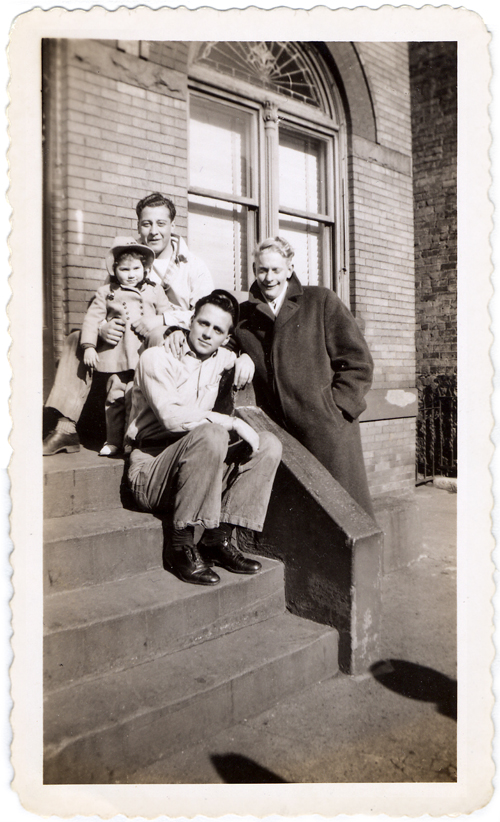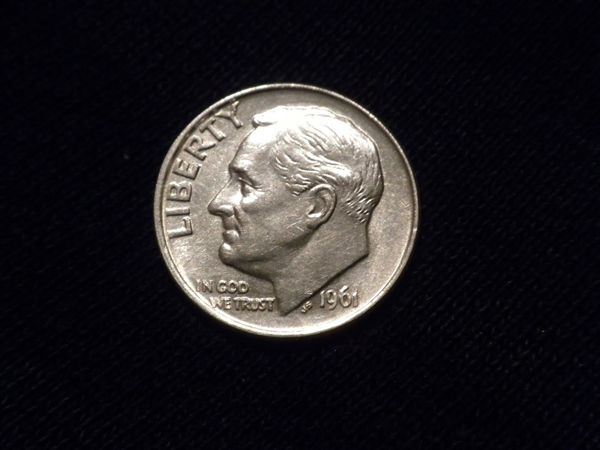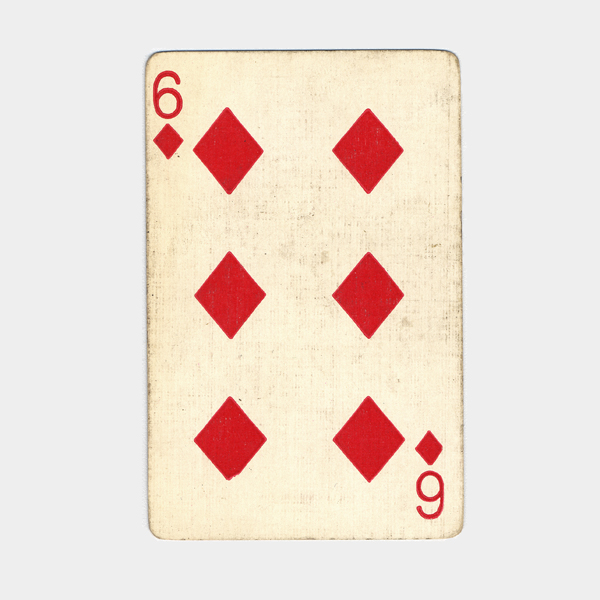Three Things: Pocket Edition

I think it’s time for another found photograph, don’t you? This one, like all photographs I pick up at flea markets, had something about it that made me want to take it home. Perhaps it’s the two people out of frame, their shadows betraying their presence? Or the great detailing on that window? Or maybe it’s the curious fact that one guy is wearing an enormous winter coat buttoned up to the neck, while the others don’t even have on a light jacket.
Whatever it is exactly, I’m conjuring up a character that carries this photograph around in his or her pocket. Along with two other things.

Found photograph, date and origin unknown.

1961 Roosevelt silver dime, via Urban Archaeology.

Playing card, six of diamonds.
Comments are closed.






It always makes me sad to see family photos at flea markets, especially when they’re stuffed into a shoebox in a corner. I end up wanting to adopt them and bring them home.
Yes! That’s certainly part of the charm, for me — giving them a new home. Someone obviously thought enough of those moments to hold up a camera and click the shutter button, and they’ve ended up completely separated and lost from their original purpose (to remember that moment, or share it with someone who would understand and enjoy it). When we take them home, I like to imagine that we’re giving them (the photos and the people in them) a new purpose, complete with new narratives and personalities — and while I’m sure they are far from accurate, they are just as fascinating. That original shutter click, then, was not in vain after all. 🙂
Yes, you said it perfectly!
Trying to grab at stories that loom in the haunt of an old, “found” photograph is like trying to grab at something miniscule, with your bare hands, that floats in an old pool close to the bottom.
On another topic, I found something that reminded me of your website (not that you need an instructional video, but here it is): http://vimeo.com/22639018
I LOVE that video! I’m happy to see they’re using wood type, which is our personal preference – it just has so much character, and every print is a little different. I really appreciate the tactile detail, such as the grain of the wood, or little imperfections.
Thanks for sharing that!
Your pool image has brought the work of photographer Carlo Van de Roer to my mind, and now I can’t shake it… and even though this has the slimmest of connections to anything we’re talking about here (read: no connection whatsoever, apart from the word “pool”), I’m going to share it anyway. He did a series titled ‘Pool’ a few years ago, consisting of gorgeous shots of abandoned (read: no water… see, I told you there was no connection*) swimming pools. Unfortunately he’s removed that series from his website, and I can’t find another source for the series in its entirety, but here’s one image: http://www.heyhotshot.com/blog/2007/11/01/hey-hot-shot-entries-carlo-van-de-roer-2/, and another: http://www.heyhotshot.com/blog/2007/11/20/fall-07-hhs-winner-carlo-van-de-roer/ for your random viewing pleasure.
P.S. I also enjoyed the vid!
*Although one could argue that these pools are concrete equivalents to found photographs, both lost to their former lives…
To Hazel: “The emptied swimming pools he photographs are rich with history, to the point of being ghostly.”
Nice find! Empty pools seems to have the same aura as the abandoned drive-in theater. I think someone should do a postcard series on “dead Americana.” All of this is stirring the imagination; thanks for sharing that.
To Wren: I concur with the wood typesetting. I like the unique imperfections that come with wood and ink: the disproportionate amounts of color, the chips in the wood, the patterns in the grain. I think the reason *I* like that is due to the fact that there is still something organic and individualistic in a process that has become mechanized.
Alec Soth beat you to it, Aaron: Thirty-three theaters and a funeral home. http://www.alecsoth.com/cinema/pages/cinema.html
Soth is a Twin Cities based photographer whose work I admire a great deal. This particular series was recently up as part of a mid-career retrospective at the Walker. I stood in front of these for probably half an hour. It was huge – took up a whole wall – and very sad.
Ah, but those were old cinemas, not drive-ins! Just kidding. Those pictures are sorrowful to me. One of my first roommates grew up operating a drive-in with his parents. He told me that the advent of daylight savings essentially was the coup de grace to the industry. Maybe I should move on to look at pictures of old farm equipment.
A few months ago one of my pen pals, who has been living and teaching in Vera, Spain, sent me a long letter. Included in the envelope, with no explanation, was a photograph that is dated “21. X. 1945” (October, I believe). In the photo are three couples, along with another gentleman. I assume that the photographer is the lonely gentleman’s partner, though he could simply be a bachelor along for the ride. There is an upturned hat and discarded coat in the bottom right corner of the photo and what appears to be a large bale of hay (I think the group is sitting in a farm field, though there are no landmarks behind them – just a clear sky).
Like Hazel, I was initially intrigued by the “unseen” in the photo – the photographer. Who is it? Are they male or female? Are they affiliated romantically with the blinking man in the picture (all three couples are looking directly at the camera)? Then I was intrigued by the couples. How do they all know one another? Where are they, how did they get there, and why did they go there? (There is a note under the date on the back that looks to say something like, “in Ber____” though I can’t make out the rest. Bermn is what it looks like, and there’s no “l” that would make it Berlin.)
I carried the photo around with me for about a month, staring it it instead of writing. I wrote a short dialogue about two people looking at the photo. One explained to the other that his parents were one of the couples, and that the lonely man was his father’s lover. I’ve written speculative poems about the lonely man and the photographer being lovers as well. As an interesting side note, all of the writing about the photo I did once I took the picture out of my notebook and left it at home on my desk.
I have yet to ask my pen pal about the photo, and I’m not sure I ever will.
That photo sounds like good writing fodder. The fact that the photo arrived on your doorstep with no explanation is fantastic! It adds even another layer of intrigue about the subjects and that day in the field.
Interesting that you didn’t write until the photo was no longer in easy reach. Did you take it out of your notebook because you felt like you knew the photo well enough that you no longer needed to study it? Or because you decided to put it aside completely, after staring at it without writing for so long? If the former, I wonder if it had just finished fermenting in your head, and that you would have begun writing around the same time no matter where the photo was — within reach or not. If the latter, perhaps you needed that space/removal in order to formulate your own versions of the characters? Either way, it’s an interesting case study that may or may not tell you something about your own writing process.
I set it aside because I needed to get it out of my head. I was becoming obsessed with the photo and needed some distance from it. Once it was no longer in easy reach I began writing about it which, in a way, kept it close and permanently in my notebook. I spent a few hours jotting down all of the speculations I’d had about the photo. Leaving it out of reach seemed to free me to write about it.
I don’t remember where I heard this – in a class, in a book or on a website – but a writer said that one should never write poems about the love affair they are currently having, unless it has been steady and stable for a number of years. I find that I’m rarely able to write about anything that is still close to me, so the necessity of setting aside the photo makes sense to me in terms of my process.
Since I took it out of my notebook the picture has stayed on my desk, where I usually do my writing, and I glace at it less and less. I’d like to find a frame for it as the corners have started to curl a bit from me holding it.